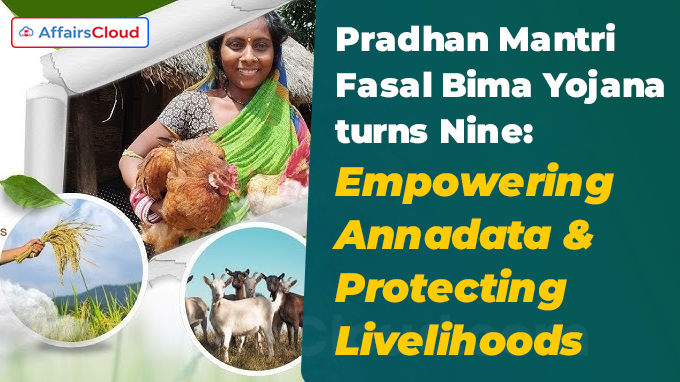 The Pradhan Mantri Fasal Bima Yojana (PMFBY), launched in 2016 by Prime Minister(PM) Narendra Modi, marked its nine-year anniversary on February 18, 2025. PMFBY is a flagship crop insurance scheme in India that operates under the Ministry of Agriculture and Farmers Welfare (MoA&FW), designed to protect farmers from financial losses due to natural calamities.
The Pradhan Mantri Fasal Bima Yojana (PMFBY), launched in 2016 by Prime Minister(PM) Narendra Modi, marked its nine-year anniversary on February 18, 2025. PMFBY is a flagship crop insurance scheme in India that operates under the Ministry of Agriculture and Farmers Welfare (MoA&FW), designed to protect farmers from financial losses due to natural calamities.
- This scheme has emerged as a cornerstone of India’s agricultural resilience, protecting over 23.22 crore farmers against crop losses caused by natural calamities and disbursing claims worth Rs.1.75 lakh crore over the past nine years.
- With its recent extension until 2025-26 and a budget allocation of Rs.69,515.71 crore, PMFBY continues to strengthen farmer welfare and sustainable agriculture.
Objectives:
- Mitigate financial risks from natural disasters like droughts, floods, cyclones, pests, and unseasonal rains.
- Stabilize farmers’ income through timely compensation, preventing debt traps.
- Encourage technology adoption and modern farming practices.
Key Features:
- Affordable Premiums: Farmers pay only 2% (Kharif crops), 1.5% (Rabi crops), or 5% (horticulture/commercial crops), with the balance subsidized by the government.
- Comprehensive Coverage: Includes yield losses, prevented sowing (up to 25% of sum insured), post-harvest losses (14 days post-harvest), and localized calamities.
- Voluntary Participation: Non-loanee farmers
The Government of India(GoI) pays entire premium for the farmers in North-Eastern States, Jammu & Kashmir(J&K), and Himachal Pradesh(HP).
Premium rate for crop insurance under PMFBY:
| Crop Type | Premium Rate (Farmer’s Share) |
|---|---|
| Kharif Crops | 2% of the sum insured |
| Rabi Crops | 1.5% of the sum insured |
| Horticulture/Commercial Crops | 5% of the sum insured |
Implementing Agencies:
PMFBY is implemented through a multi-agency framework involving:
- Insurance Companies: Selected by the government to provide coverage.
- Government Departments: Agriculture, Cooperation, Horticulture, Revenue, and Panchayati Raj.
- Financial Institutions: Commercial Banks, Cooperative Banks, and Regional Rural Banks.
- Regulatory Bodies: Overseeing the implementation and ensuring transparency.
Technological Innovations:
PMFBY’s success hinges on its technology-driven framework, ensuring transparency and efficiency:
- Remote Sensing & Drones: Used for crop area estimation, yield assessment, and loss evaluation, reducing human error.
- YES-TECH (Yield Estimation System Based on Technology): Introduced in Kharif 2023, it blends satellite-based yield estimates with manual data, gradually phasing out traditional Crop Cutting Experiments (CCEs). States like Madhya Pradesh(MP) have adopted 100% tech-based assessments.
- CCE-Agri Application: Direct upload of crop data to the National Crop Insurance Portal (NCIP) for real-time monitoring.
- Weather Information and Network Data System (WINDS)Initiative: A Rs.824.77 crore Fund for Innovation and Technology (FIAT) supports hyperlocal weather data through Automatic Weather Stations (AWS) and Automatic Rain Gauges (ARGs), enhancing claim accuracy.
Impact and Achievements
- Financial Security: Over Rs.1.70 lakh crore paid in claims since 2016, with 25% enrollment growth in 2023-24.
- Global Recognition: PMFBY is the world’s largest crop insurance scheme by farmer participation.
- 23 states and Union Territories(UTs) are implementing the scheme. Non-loanee farmers’ coverage has increased to 55% of the total coverage
- 25% growth in farmer enrolment numbers (2023-24 vs 2022-23). Sum insured of rs. 17,29,395 crore
- Regional Focus: Northeastern states receive 90% premium subsidies to boost coverage.
About Pradhan Mantri Fasal Bima Yojana(PMFBY):
Ministry – Ministry of Agriculture and Farmers Welfare (MoA&FW)
Administered – Department of Agriculture, Cooperation & Farmers Welfare (DAC&FW), MoA&FW
Chief Executive Officer (CEO) –Muktanand Agrawal



